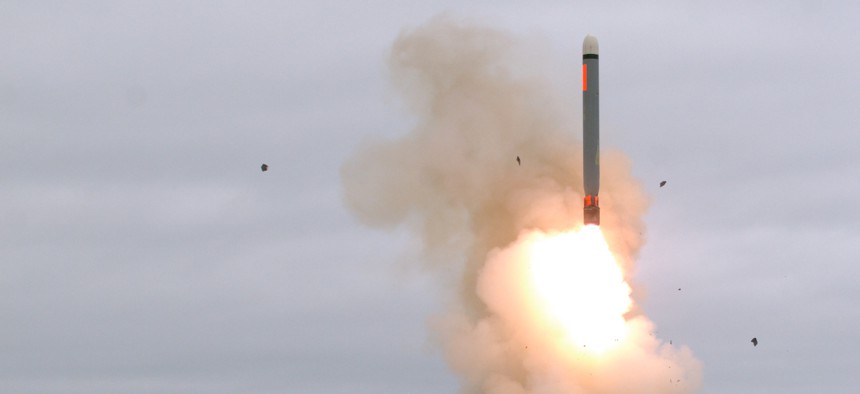
A ground-launched cruise missile lifts off for a test flight at 2:30 p.m. on Aug. 18, at San Nicolas Island, Calif., a U.S. Navy test facility. Scott Howe / DOD
The US Just Launched a Long-Outlawed Missile. Welcome to the Post-INF World
Sunday’s test sent a ground-launched missile more than 500 kilometers, a test that would have been illegal last month.
This post has been updated.
With the test-launch of a ground-based missile that flew more than 500 kilometers, the United States strode boldly into a future that past leaders had tried to avoid.
The announcement arrived in a terse Pentagon news release sent to media just after noon on Monday: “On Aug. 18, at 2:30 p.m. Pacific Daylight Time, the Defense Department conducted a flight test of a conventionally configured ground-launched cruise missile at San Nicolas Island, Calif. The test missile exited its ground mobile launcher and accurately impacted its target after more than 500 kilometers of flight. Data collected and lessons learned from this test will inform DOD's development of future intermediate-range capabilities.”
The missile was a "variant of the Tomahawk Land Attack Cruise Missile," Air Force Lt. Col. Robert Carver, a DoD spokesman, told Military.com, launched by the U.S. Navy and DoD's Strategic Capabilities Office.
But the Army has also been tiptoeing up to the 500-km limit as it develops a next-generation artillery weapon called the Precision Strike Missile. Dubbed the PrSM for short, it is intended as a longer-ranged replacement for the missiles currently fired by the Army’s M270A1 Multiple Launch Rocket System, or MLRS, and the M142 High Mobility Artillery Rocket System, or HIMARS.
So far, the PrSM has an official range of 499 kilometers. That’s because missiles with longer ranges — between 500 and 5,500 kilometers — were deemed in the 1980s to be so dangerous and destabilizing that the United States and Russia came together to ban them in the Intermediate-Range Nuclear Forces Treaty.
Related: This Army Missile Might be the Pentagon’s First Post-INF Weapon
Related: China Is No Reason to Abandon the INF
Related: Save This One Piece of the INF Treaty
Last year, the director of the Army’s long-range-precision fires team said the PrSM was ready to go farther.
“We have worked with our industry partners to determine what is the feasibility going farther than 499 kilometers and we believe that it’s entirely possible to go further with the current missile,” Col. John Rafferty told reporters. “Our discussions about advanced propulsion leads us to believe that inside the same form factor, with a change in propulsion, we could go significantly farther.”
Added Rafferty: “We’re going to play by the rules until we’re told the rules have changed.”
The rules have now changed. On Aug. 2, the United States formally withdrew from the treaty, citing Russian violations related to the 9M729 missile.




